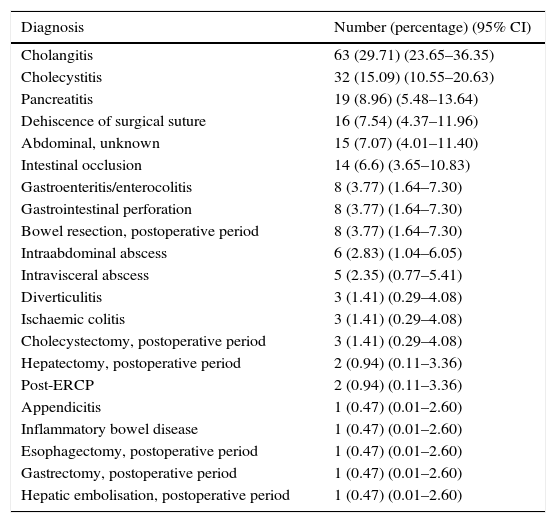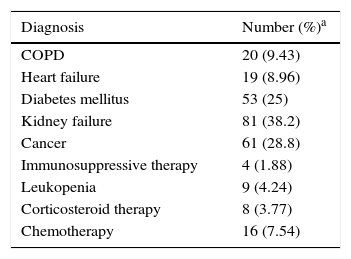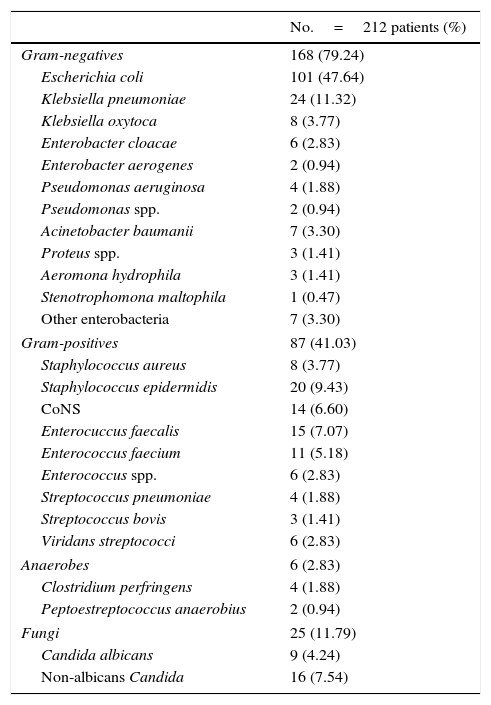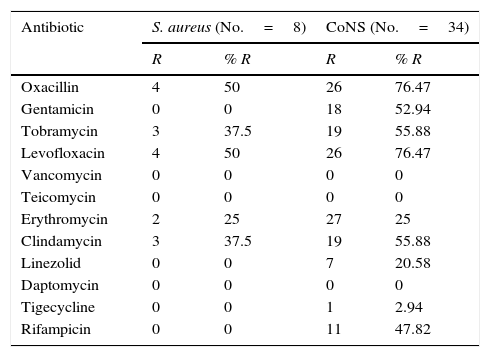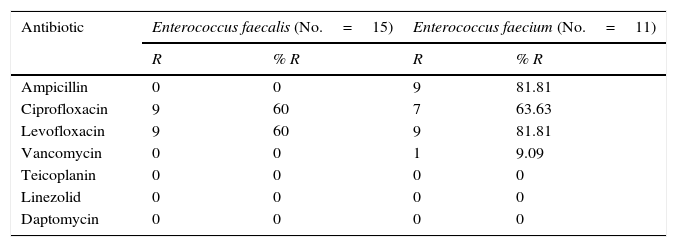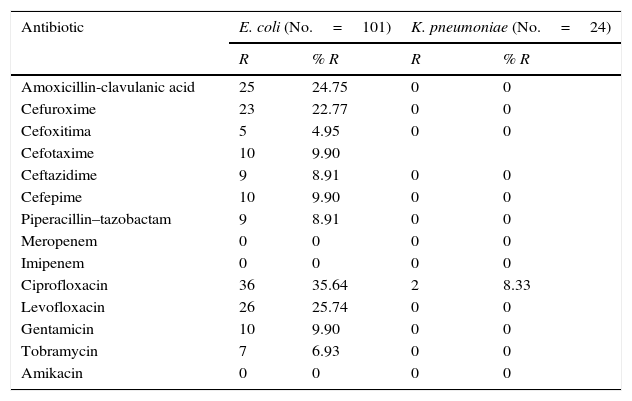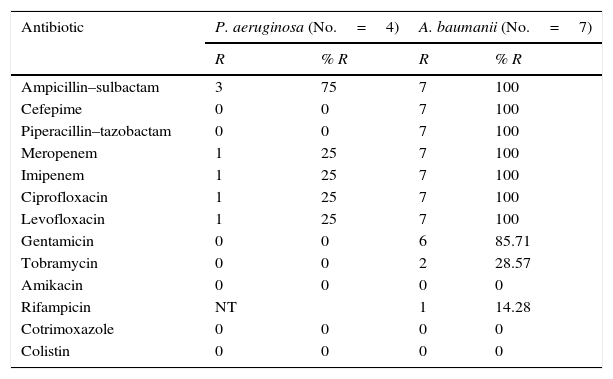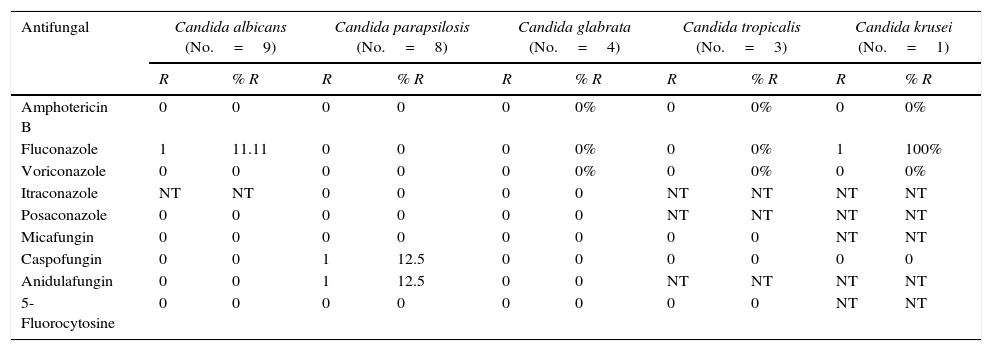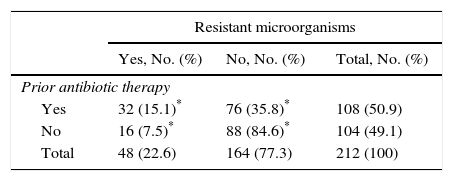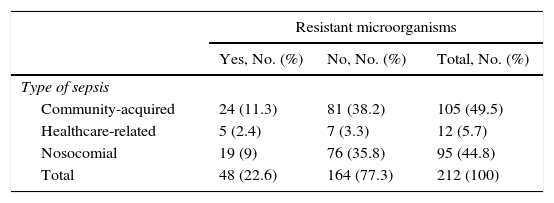The presence of resistant microorganisms is a major cause of failure in initial empirical antimicrobial therapy. The objectives of this study are to determine the resistance profile of microorganisms that cause bacteraemia of abdominal origin and to identify whether the previous use of antibiotics and the place of acquisition of bacteraemia are risk factors associated with the presence of resistant organisms.
Material and methodsA clinical, observational, epidemiological, retrospective cohort study was conducted with all the adult patients admitted to a university hospital from 2011 to 2013. Antimicrobial resistance profiles were described and a 95% confidence interval chi-square test was used to determine whether the variables studied were risk factors in the isolation of resistant microorganisms.
ResultsOf the 1245 patients with bacteraemia, 212 (17%) presented bacteraemia of abdominal origin. The resistance profile highlights the incidence of methicillin resistant Staphylococcus aureus (50%), coagulase-negative staphylococci resistant to linezolid (20.58%), enterococci resistant to vancomycin (3.12%), Escherichia coli resistant to third-generation cephalosporins (9.9%) and fluoroquinolones (35.64%), Klebsiella pneumoniae resistant to third-generation cephalosporins (8.33%), Pseudomonas aeruginosa resistant to fluoroquinolones and carbapenem (25% and 25% respectively) and Acinetobacter baumanii resistant to fluoroquinolones and carbapenem (100% and 100% respectively), Candida albicans resistant to fluconazole (11.11%), single Candida krusei isolate resistant to fluconazole and Candida parapsilosis resistant to echinocandins (12.5%). In our study, previous use of antibiotics had a statistically significant association with the isolation of resistant microorganisms (p=0.013) but not the place of acquisition of bacteraemia (p=0.239).
ConclusionEstablishing the incidence of resistant organisms can improve empirical antimicrobial therapy in patients with bacteraemia of abdominal origin. Previous use of antibiotics was statistically significantly related to the isolation of resistant microorganisms.
La presencia de microorganismos resistentes es una causa importante de fallo en el tratamiento antimicrobiano inicial. Los objetivos de este estudio son conocer el perfil de resistencia de los microorganismos causantes de bacteriemia de origen abdominal e identificar si el uso previo de antibióticos y el lugar de adquisición de la bacteriemia son factores de riesgo para determinar la presencia de microorganismos resistentes.
Material y métodoSe diseñó un estudio de cohorte retrospectiva de todos los pacientes adultos que presentaron bacteriemia y/o fungemia cuyo foco infeccioso primario fue de origen abdominal ingresados en un hospital universitario durante los años 2011-2013. Se describieron los perfiles de resistencia a los antimicrobianos y se utilizó una comparación de proporciones con un test chi cuadrado al 95% de confianza para determinar si las variables estudiadas fueron factores de riesgo en el aislamiento de microorganismos resistentes.
ResultadosDe un total de 1.245 pacientes con bacteriemia, 212 (17%) presentaron bacteriemia de origen abdominal. Respecto al perfil de resistencias destacó Staphylococcus aureus resistente a meticilina (50%), estafilococos coagulasa negativos resistentes a linezolid (20,58%), enterococos resistentes a vancomicina (3,12%), Escherichia coli resistente a cefalosporinas de 3.a generación (9,9%) y fluorquinolonas (35,64%), Klebsiella pneumoniae resistente a fluorquinolonas (8,33%), Pseudomonas aeruginosa resistente a quinolonas y carbapenem (25 y 25% respectivamente), Acinetobacter baumanii resistente a quinolonas y carbapenem (100% y 100% respectivamente), Candida albicans resistente a fluconazol (11,11%), la única Candida krusei aislada resistente a fluconazol y Candida parapsilosis resistente a equinocandinas (12,5%). En nuestro estudio, el uso previo de antibiótico tuvo asociación estadísticamente significativa con el aislamiento de microorganismos resistentes (p=0,013) pero no el lugar de adquisición de la bacteriemia (p=0,239).
ConclusionesConocer la incidencia de microorganismos resistentes en cada hospital puede mejorar el tratamiento antimicrobiano empírico inicial en pacientes con bacteriemia de origen abdominal. El uso previo de antibióticos se relacionó de forma estadísticamente significativa con el aislamiento de microorganismos resistentes.






